
ISO 216 is an international standard for paper sizes, used around the world except in North America and parts of Latin America. The standard defines the "A", "B" and "C" series of paper sizes, including A4, the most commonly available paper size worldwide. Two supplementary standards, ISO 217 and ISO 269, define related paper sizes; the ISO 269 "C" series is commonly listed alongside the A and B sizes.

An envelope is a common packaging item, usually made of thin, flat material. It is designed to contain a flat object, such as a letter or card.

Paper size standards govern the size of sheets of paper used as writing paper, stationery, cards, and for some printed documents.

Stationery refers to commercially manufactured writing materials, including cut paper, envelopes, writing implements, continuous form paper, and other office supplies. Stationery includes materials to be written on by hand or by equipment such as computer printers.

A perforation is a small hole in a thin material or web. There is usually more than one perforation in an organized fashion, where all of the holes collectively are called a perforation. The process of creating perforations is called perforating, which involves removing bits of the workpiece with a tool. Old-fashioned lick-and-stick postage stamps are perforated. When a tool makes small cuts in the material it's called 'rouletting', because that tool often resembles a roulette wheel, with blades around the edge. Raffle tickets are a good example of rouletting.
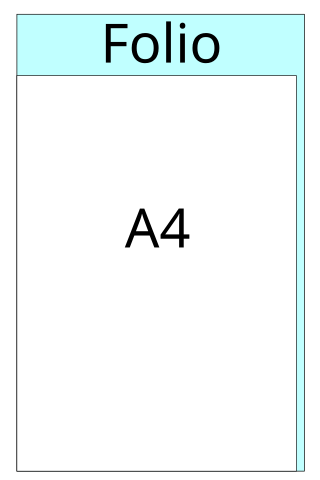
Foolscap folio is paper cut to the size of 8+1⁄2 × 13+1⁄2 in (216 × 343 mm) for printing or to 8 × 13 in (203 × 330 mm) for "normal" writing paper (foolscap). This was a traditional paper size used in some parts of Europe, and the British Commonwealth, before the adoption of the international standard A4 paper.
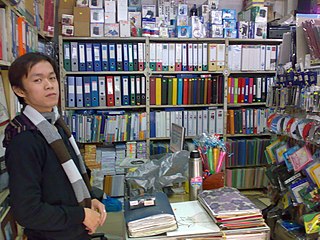
Office supplies are consumables and equipment regularly used in offices by businesses and other organizations, by individuals engaged in written communications, recordkeeping or bookkeeping, janitorial and cleaning, and for storage of supplies or data. The range of items classified as office supplies varies, and typically includes small, expendable, daily use items, consumable products, small machines, higher cost equipment such as computers, as well as office furniture and art.

A hole punch, also known as hole puncher, or paper puncher, is an office tool that is used to create holes in sheets of paper, often for the purpose of collecting the sheets in a binder or folder. A hole punch can also refer to similar tools for other materials, such as leather, cloth, or plastic or metal sheets.
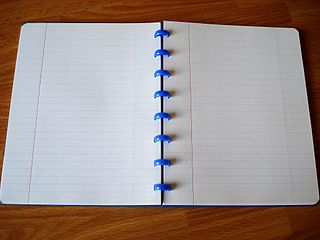
Ruled paper is writing paper printed with lines as a guide for handwriting. The lines often are printed with fine width and in light colour and such paper is sometimes called feint-ruled paper. Additional vertical lines may provide margins, act as tab stops or create a grid for plotting data; for example, graph paper is divided into squares by horizontal and vertical lines.
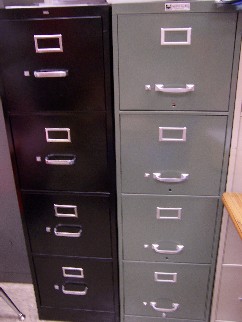
A filing cabinet is a piece of office furniture for storing paper documents in file folders. In the most simple context, it is an enclosure for drawers in which items are stored. The two most common forms of filing cabinets are vertical files and lateral files. A vertical file cabinet has drawers that extend from the short side of the cabinet. A lateral file cabinet has drawers that extend from the long side of the cabinet. These are also called side filers in Great Britain. There are also shelf files which go on shelves. In the United States, file cabinets are usually built to accommodate 8.5 × 11 paper, and in other countries, filing cabinets are often designed to hold other sizes of paper, such as A4 paper.

Ring binders are large folders that contain file folders or hole punched papers. These binders come in various sizes and can accommodate an array of paper sizes. These are held in the binder by circular or D-shaped retainers, onto which the contents are threaded. In North America, the rings themselves come in a variety of sizes, including 0.5, 1, 1.5, and 2 inches, though other sizes are also available. The rings may be secured by lever arch mechanisms or other securing systems, or may be spring-loaded. The binders themselves are typically made from plastic with metal rings. Early designs were patented during the early 1890s to the early 1900s.
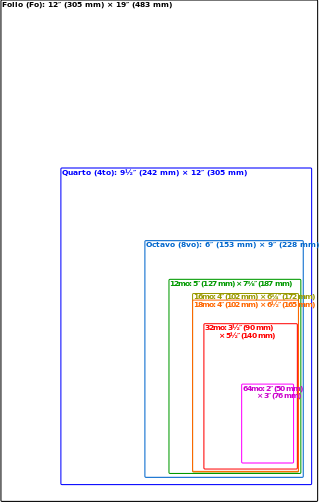
The size of a book is generally measured by the height against the width of a leaf, or sometimes the height and width of its cover. A series of terms is commonly used by libraries and publishers for the general sizes of modern books, ranging from folio, to quarto (smaller) and octavo. Historically, these terms referred to the format of the book, a technical term used by printers and bibliographers to indicate the size of a leaf in terms of the size of the original sheet. For example, a quarto historically was a book printed on sheets of paper folded in half twice, with the first fold at right angles to the second, to produce 4 leaves, each leaf one fourth the size of the original sheet printed – note that a leaf refers to the single piece of paper, whereas a page is one side of a leaf. Because the actual format of many modern books cannot be determined from examination of the books, bibliographers may not use these terms in scholarly descriptions.
Paper drilling is a technique used in trade binderies for providing large quantities of paper with round holes. The paper can be processed as loose leaves and in brochures. The holes usually serve for storage (filing), sometimes for decorative purposes by eccentric individuals.

An exercise book or composition book is a notebook that is used in schools to copy down schoolwork and notes. A student will usually have a different exercise book for each separate lesson or subject.
Grammage and basis weight, in the pulp and paper industry, are the area density of a paper product, that is, its mass per unit of area. Two ways of expressing grammage are commonly used:

Continuous stationery (UK) or continuous form paper (US) is paper which is designed for use with dot-matrix and line printers with appropriate paper-feed mechanisms. Other names include fan-fold paper, sprocket-feed paper, burst paper, lineflow, tractor-feed paper, and pin-feed paper. It can be single-ply or multi-ply, often described as multipart stationery or forms. Continuous stationery is often used when the final print medium is less critical in terms of the appearance at the edges, and when continuously connected individual sheets are not inconvenient for the application. Individual sheets can be separated at the perforation, and sheets also have edges with punched holes, which also can be removed at the perforation.

Disc-binding is a type of notebook binding that uses discs to hold the sheets of paper. Each disc has a raised edge. Notebook sheets have perforations along the binding edge that match the profile and spacing of the binding discs.

The term "folio" has three interconnected but distinct meanings in the world of books and printing: first, it is a term for a common method of arranging sheets of paper into book form, folding the sheet only once, and a term for a book made in this way; second, it is a general term for a sheet, leaf or page in (especially) manuscripts and old books; and third, it is an approximate term for the size of a book, and for a book of this size.

Bookbinding is the process of building a book, usually in codex format, from an ordered stack of paper sheets with one's hands and tools, or in modern publishing, by automated processes. Firstly, one binds the sheets of papers along an edge with a thick needle and strong thread. One can also use loose-leaf rings, binding posts, twin-loop spine coils, plastic spiral coils, and plastic spine combs, but they last for a shorter time. Next, one encloses the bound stack of paper in a cover. Finally, one places an attractive cover onto the boards, and features the publisher's information and artistic decorations.
















